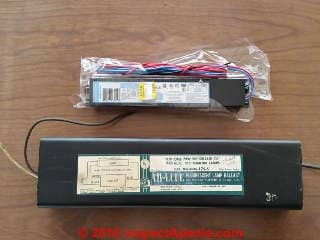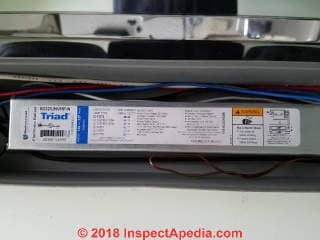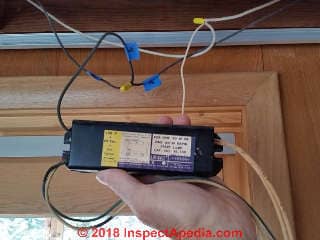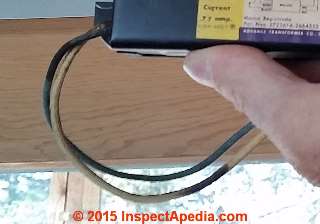 Fluorescent Light Ballast Types
Fluorescent Light Ballast Types
Choose the right transformer or ballast
- POST a QUESTION or COMMENT about building electrical systems, power, wiring, and flickering or dimming lights
How to find the right replacement ballast or transformer for a fluorescent light fixture.
If you have already tried replacing bulbs, starters, connectors, or if the fixture hums like a machine, it's time to replace the ballast.
This article series explains how to diagnose the causes of flickering or dimming fluorescent lights at or in buildings.
InspectAPedia tolerates no conflicts of interest. We have no relationship with advertisers, products, or services discussed at this website.
Types of Fluorescent Light Ballast
 at HOW FLUORESCENT LIGHTS WORK we explain that
at HOW FLUORESCENT LIGHTS WORK we explain that
Fluorescent lamps have two electrical requirements.
To start the lamp, a high voltage surge is needed to establish an arc in the mercury vapor.
Once the lamp is started, the gas offers a decreasing amount of resistance, which means that current must be regulated to match this drop. Otherwise, the lamp would draw more and more power and rapidly burn itself out.
This is why fluorescent lamps ... must be operated by a ballast, which provides the required starting voltage and then controls the subsequent flow of current to the lamp. - sources: Sylvania cited in detail
at FLUORESCENT LAMP INSTRUCTIONS, PARTS, REPLACEMENTS
[Click to enlarge any image]
There are two different break-downs of fluorescent light fixture ballast types, as we explain here.
- Magnetic vs. Electronic ballasts
- Ballast designs using different lamp-starting strategies.
Above: top of photo: an older magnetic ballast produced by Advance Transformer Co, used to support a 30-Watt or 40-Watt rapid-start fluorescent lamp. This ballast was retrieved from a fluorescent light fixture installed in 1963 in a home in northern Minnesota.
Watch out: older ballasts may contain harmful PCBs.
[Click to enlarge any image]
Bottom of same photo: a new magnetic ballast from Phillips Advance, designed to support a range of fluorescent lamps from 13-Watts to 20-Watts. This transformer / ballast is PCB-free.
Magnetic vs Electronic Ballast / Transformer
Magnetic ballast: (shown in the photo above) used in high-intensity discharge (HID) lamps and in older fluorescent light fixtures, a magnetic ballast is an older and simple ballast design using a magnetic core and coil transformer to produce high voltage.
Electronic ballast: (shown below) used in newer fluorescent light fixtures, electronic components (rather than a heavy wire winding core) are used to produce the high voltage needed to start the light fixture.
Electronic ballasts are smaller and lighter than older magnetic ballasts, and are sold as replacements for the older units.
Shown above, a Triad electronic ballast for fluorescent light fixtures.
This Triad electronic ballast, produced by Universal Lighting Technologies, (Model B232iUNVHP-N) can support two rapid-start T8 type lamps including 25W and 30W bulbs.
This is a PCB-free ballast using semi-conductors.
Electronic ballast can be used to replace both the
starting element and the conventional ballast of
fluorescent lamps.
Although they are more complex and costly than
their electromagnetic counterparts, they offer
increased light output efficiency, reduced weight,
and a removal of the problems of flicker.
All this is
achieved by increasing the frequency at which the
tube is driven above the 50Hz defined by the mains
frequency. The higher initial cost of the system will
eventually be compensated for by the reduction in
energy consumed. (STMicroelectronics 1999)
Next let's look at another old and new ballast pair used to light a center-pin FA6 base fluorescent lamp (bulb).
 This photo compares a pair of old and new ballasts.
This photo compares a pair of old and new ballasts.
The original magnetic ballast, at the bottom of the photo, is an Advance Ad-Lite Fluorescent Lamp Ballast produced by Advance Transformer Co. (Chicago) in the 1960s is far larger and heavier than the Philips Advance IntellilVolt replacement electronic ballast used to replace it.
The new ballast, uppermost in the photo, can support two F96T12- 75W lamps or two F96T12- 60W lamps, and is also compatible with additional fluorescent lamp models as detailed on the label.
This is an instant start electronic ballast and is free of any PCBs.
The original ballast, at the bottom of the photo, supported one 74W 96" T12 slimline fluorescent lamp, or one 55W 72" T12 slimline lamp. Additional ballast rating information is on the label of each product.
Three Types of Lamp Starting Methods in Transformers / Ballasts
The choice of fluorescent lamp starting method affects the electricity costs of operating the lighting system as well as its start-up behavior.
RS: Rapid Start Ballasts: the high starting voltage required to ignite the fluorescent lamp is applied simultaneously with the operation of heating the electrodes within the lamp or bulb.
This reduces the required start-up voltage but the electrode heating operation continues as long as the bulb is on - increasing operating cost, while at the same time, increasing the life of the bulb.
IS: Instant Start Ballasts: high voltage is applied to ignite or start the fluorescent lamp without heating the lamp's internal electrodes.
The result is reduced operating cost and energy use but at the cost of a shorter bulb life where older IS ballasts are in use. Sylvania currently provides a QUICKTRONIC® electronic ballast that improves bulb life.
PRS: Programmed Rapid Start Ballast: the electrodes are pre-heated to optimum temperature before the high voltage needed to ignite the lamp is applied. The result is longer electrode life and fewer switching cycles (probably also reduced start-up flickering).
While the company's explanation doesn't use the phrase "flickering light", it's probably that reduced flickering during lamp start-up that explains why Sylvania notes that this ballast type addresses ... a critical issue in occupancy sensor applications.
- Source: Osram Sylvania, FLUORESCENT LIGHT BALLAST TECHNOLOGY [PDF], retrieved 2018/09/17, original source: https://www.sylvania.com/en-us/innovation/education/light-and-color/Pages/ballasts-technology.aspx
Above: I have labeled the wires on the original ballast as well as at the fluorescent light fixture before disconnecting the ballast to remove it.
Labeling wires on the ballast as well as at the fixture helps translate old to new wiring diagrams since on the new ballast the equivalent wires may be in a different position.
Take a closer look at the wiring on the original ballast in our photo below:
This ballast wire was overheating - providing a clue that the unit needed to be replaced. Another clue was that the fluorescent light would not work even after replacing the bulb and starter with units that we confirmed were working in other fixtures.
Other Ballast Types
Universal Lighting Technologies as well as other ballast manufacturers' catalogs will virtually all provide additional ballast designs, typically for special applications.
Examples, borrowing from Universal (cited in detail just below) include
ULTim8® Programmed Start Applications
Features true parallel lamp operation and fast start time (<700ms) so that if one lamp fails, other lamps stay lit. “Soft start” technology maintains lamp life, making these the perfect choice for high-cycling applications like occupancy sensors. Designed for use with 30, 28 and 25 Watt energy saving lamps for even more energy savings.
- Same benefits as Instant Start plus ...
- Available in high efficiency HE normal (.88) and EL low (.71), and HEH (1.18) ballast factor versions.
- Programmed Start ballasts are designed to quickly pre-heat lamp cathodes up to their optimum starting temperature and ignite the lamps quickly.
- Filament cut out on HE and HEH models for instant start level efficiency.
- The quick ignition results in long lamp life without the typical long delay during turn-on.
- Same 5 year warranty as instant start or 3-year warranty for HEH modules when operated at 90° C case temperature.
High Lumen and High Bay Applications
ULTim8® High Lumen ballasts are the high efficiency high ballast factor choice for high lumen T8 applications. ULTim8® HB ballasts are designed to provide excellent performance in the high ambient temperature applications where high bay fluorescent fixtures are installed.
EL Ballasts:
Used often when retrofitting existing T12 fixtures with T8 lamps to tune down lamp output.
Application areas include stairwells, hallways, bathrooms and other areas that are lit partially during the day.
They are good for using in low light level areas. Change light levels with ballast factor.
HE Ballasts:
Used often in new construction, the high efficiency version of our standard HP product. Used for
frequently switched applications including occupancy sensors and daylight harvesting.
HEH Ballasts
Used to overdrive lamps. Use these for areas with high light output.
- Source: Universal Lighting Technologies, BALLAST NAVIGATOR CATALOG [PDF] provides a guide to selecting ballasts for all types of fluorescent light fixtures, Universal Lighting Technologies, TEl: 1-800-BALLAST, Website: https://unvlt.com/literature/ballast-navigator/ produces electronic ballasts for fluorescent light fixtures. Universal produces the Triad® brand of lamp ballasts.
Change the Ballast if Changing from T12 to T8 Fluorescent Bulbs
T8 lamps require a ballast specifically designed to operate lamps at 265 milliamperes (mA), rather than the 430 mA that T12 lamps require.
In almost all cases, whenever T12 lamps are replaced with T8 lamps, the ballast must also be replaced.
At least one manufacturer offers an electronic ballast that can operate either lamp type; however, T8 lamps have higher input power and higher light output on this ballast than on a ballast that only operates T8 lamps.
Ballasts for T8 lamps are available for 120 volt (V), 277 V, 240 V, or 347 V operation. Ballast types include magnetic, which operate the lamps at 60 hertz (Hz), cathode-disconnect (also 60 Hz lamp operation), and electronic.
Electronic ballasts improve the efficacy of T8 lamps by operating them at much higher frequencies than the standard 60 Hz at which magnetic ballasts operate lamps.
Fluorescent lamps of a given wattage that are operated at high frequencies (³ 20,000 Hz) produce 10 to 12 percent more light than the same lamps operated at 60 Hz.
Thus, a fluorescent lighting system using high-frequency electronic ballasts requires less electricity to produce the same amount of light as a 60 Hz magnetic ballast system. ... most commercially available electronic ballasts provide a slight reduction in light output while using significantly less power compared to magnetic ballasts.
Many electronic ballasts offer other advantages, such as reduced flicker, less heat, less noise, and the ability to operate as many as four lamps on a single ballast; some offer dimming and better power quality characteristics.
- source: NLPIP, T8 FLUORESCENT LAMPS [PDF] (1993), National Lighting Product Information Program (NLPIP), Lighting Research Center, Rensselaer Polytechnic Institute, Troy, NY 12180 USA Vol. 1 No. 1, June 2006, retrieved 2018/09/17, original source: https://www.lrc.rpi.edu/programs/NLPIP/lightinganswers/pdf/view/LAT8.pdf
Flourescent Lamp Ballast Date Codes
- Douglas Lighting, FLOURESCENT FIXTURE BALLAST DATE CODES [PDF] Universal Lighting Technologies, retrieved 2021/07/07 original source: https://nunvdata.unvlt.com/uploads/Manufactuing-Date-Codes.pdf
...
Continue reading at FLUORESCENT LIGHT FIXTURE BULB / BALLAST DISPOSAL or select a topic from the closely-related articles below, or see the complete ARTICLE INDEX.
Or see these
Recommended Articles
- DIAGNOSE a BAD FLUORESCENT LAMP / BULB
- ELECTRIC POWER LOSS / FLICKERING LIGHTS
- FLUORESCENT LIGHTING GUIDE INDOORS for Indoors and Guide to Using Compact Fluorescent Lights
- FLUORESCENT LIGHTS COMPACT INDOOR
- FLUORESCENT LIGHT REPAIRS - home
- HOW FLUORESCENT LIGHTS WORK
- ELECTRIC POWER LOSS / FLICKERING LIGHTS
- DIAGNOSE a BAD FLUORESCENT LAMP / BULB
- REPLACE a FLUORESCENT LAMP / BULB
- FLUORESCENT LIGHT BALLAST TYPES
- FLUORESCENT LIGHT BULB CODES & TYPES
- FLUORESCENT LIGHT BULB PHOTOS
- FLUORESCENT LIGHT BULB COLOR TEMPERATURE
- FLUORESCENT LIGHT FLICKERING CAUSES
- FLUORESCENT LIGHT STARTER REPLACEMENT
- FLUORESCENT LIGHT TRANSFORMER / BALLAST REPLACEMENT
- FLUORESCENT LIGHT TRANSFORMER / BALLAST TYPES
- FLUORESENT BULB SOCKET TYPES
- FLUORESCENT LAMP CONNECTOR / SOCKET REPLACEMENT
- FLUORESCENT LIGHT FIXTURE BULB / BALLAST DISPOSAL
- FLUORESCENT LAMP INSTRUCTIONS, PARTS, REPLACEMENTS
- FLUORESCENT vs INCANDESCENT BULBS
Suggested citation for this web page
FLUORESCENT LIGHT TRANSFORMER / BALLAST TYPES at InspectApedia.com - online encyclopedia of building & environmental inspection, testing, diagnosis, repair, & problem prevention advice.
Or see this
INDEX to RELATED ARTICLES: ARTICLE INDEX to ELECTRICAL INSPECTION & TESTING
Or use the SEARCH BOX found below to Ask a Question or Search InspectApedia
Ask a Question or Search InspectApedia
Try the search box just below, or if you prefer, post a question or comment in the Comments box below and we will respond promptly.
Search the InspectApedia website
Note: appearance of your Comment below may be delayed: if your comment contains an image, photograph, web link, or text that looks to the software as if it might be a web link, your posting will appear after it has been approved by a moderator. Apologies for the delay.
Only one image can be added per comment but you can post as many comments, and therefore images, as you like.
You will not receive a notification when a response to your question has been posted.
Please bookmark this page to make it easy for you to check back for our response.
Our Comment Box is provided by Countable Web Productions countable.ca
Citations & References
In addition to any citations in the article above, a full list is available on request.
- Our recommended books about building & mechanical systems design, inspection, problem diagnosis, and repair, and about indoor environment and IAQ testing, diagnosis, and cleanup are at the InspectAPedia Bookstore. Also see our Book Reviews - InspectAPedia.
- In addition to citations & references found in this article, see the research citations given at the end of the related articles found at our suggested
CONTINUE READING or RECOMMENDED ARTICLES.
- Carson, Dunlop & Associates Ltd., 120 Carlton Street Suite 407, Toronto ON M5A 4K2. Tel: (416) 964-9415 1-800-268-7070 Email: info@carsondunlop.com. Alan Carson is a past president of ASHI, the American Society of Home Inspectors.
Thanks to Alan Carson and Bob Dunlop, for permission for InspectAPedia to use text excerpts from The HOME REFERENCE BOOK - the Encyclopedia of Homes and to use illustrations from The ILLUSTRATED HOME .
Carson Dunlop Associates provides extensive home inspection education and report writing material. In gratitude we provide links to tsome Carson Dunlop Associates products and services.




